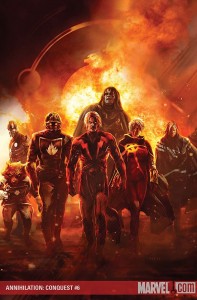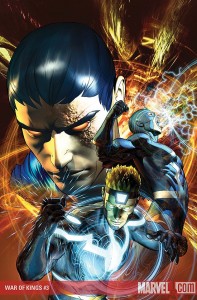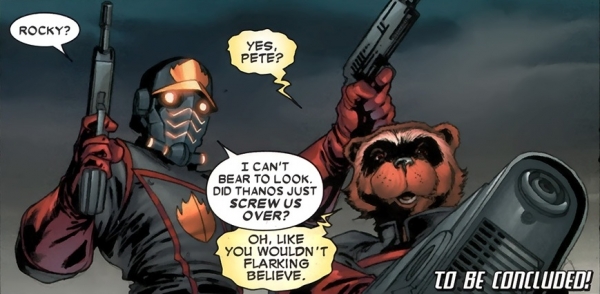 With the completion of The Thanos Imperative, Marvel brought an end to several years of epic storytelling in their Marvel Cosmic line of comics. Envisioned and given life by Marvel heavyweights like Stan Lee, Jack Kirby, Jim Shooter and Jim Starlin, the Marvel Cosmic setting reached its height of popularity in the 70s and 80s. While the characters would continue their grand adventures over the years, the setting wouldn’t see major success again until it was revitalised in 2005’s “Annihilation” event. Since then, the Cosmic comics have been delivering some of Marvel’s best writing and its most consistently high-quality stories.
With the completion of The Thanos Imperative, Marvel brought an end to several years of epic storytelling in their Marvel Cosmic line of comics. Envisioned and given life by Marvel heavyweights like Stan Lee, Jack Kirby, Jim Shooter and Jim Starlin, the Marvel Cosmic setting reached its height of popularity in the 70s and 80s. While the characters would continue their grand adventures over the years, the setting wouldn’t see major success again until it was revitalised in 2005’s “Annihilation” event. Since then, the Cosmic comics have been delivering some of Marvel’s best writing and its most consistently high-quality stories.
For the last few years, and especially since the start of The Thanos Imperative, I’ve been recommending these comics to everyone. However, due to the relative obscurity of many of these characters as opposed to Spider-Man or Captain America, it’s hard for many to get into these stories. So, I present to you my Guide to Marvel Cosmic, this time detailing the Story.
Of course, there will be spoilers here. My goal is to give readers a general understanding of past events, so if they find a particular story interesting, they have some knowledge going in. I also believe that having a general understanding of the events of a storyline won’t negatively affect your enjoyment of the writing, artwork and smaller details.
Annihilation
The primary writer for the “Annihilation” event was Keith Giffen. While he has experience with cosmic stories from his work on Legion of Super-Heroes, Giffen hasn’t been known for serious stories. Still, he pulled together an absolutely epic event that nobody saw coming and the quality was astounding.
“Annihilation” was released as a prologue issue, a collection of miniseries focusing on the characters of Nova, Silver Surfer, Ronan the Accuser and the Super-Skrull, then finally the Annihilation miniseries itself. Annihilation: Prologue focuses on the events of “Annihilation Day” where the forces of the Annihilation Wave pour out of the Negative Zone and destroy the Kyln power generators and prisons as well as the entire Nova Corps, cutting off the galaxy’s best defenses immediately. The leader of the Annihilation Wave is revealed to be none other than Annihilus.
In the Annihilation: Nova miniseries, Nova has to deal with being the last member of the Corps. He bonds with the Worldmind, gaining the collective knowledge and power of the entire Nova Corps. He helps Quasar and Drax evacuate the residents of a planet about to be hit by the Annihilation Wave before attacking Annihilus himself, a battle that would end with the death of Quasar.
Annihilus would go after Galactus and his Heralds in Annihilation: Silver Surfer, pushing the Surfer to once again ally himself with the World Eater. Ronan would be accused of treason in Annihilation: Ronan, meeting Gamora while on the run, while Super-Skrull would sacrifice himself to stop a planet-destroying weapon in Annihilation: Super-Skrull.
The various minis leading up to Annihilation aren’t central to the plot, but they set everything up and introduce the characters, moving all the pieces where they need to be. Of course, there’s some great stories to read in there, too. Annihilation tells the story of Nova and his allies fighting against Annihilus, now allied with Thanos, as if one massive threat weren’t enough. Annihilus has decided to invade the “normal” universe since its never-ending expansion is starting to encroach on his territory in the Negative Zone. He believes this gives him the right to claim our dimension as his own. Thanos, seeing the destruction wrought by the Annihilation Wave, sees this as an excellent opportunity to please Death.
Thanos takes down Galactus and the Silver Surfer, enabling Annihilus to steal their Power Cosmic. Drax manages to accomplish the purpose he was created for by killing Thanos and freeing Galactus, who destroys a majority of the Annihilation Wave forces in retaliation. Ronan frees the Kree homeworld from Annihilus’ control, and is chosen their new leader. With his forces diminished and his footholds in the galaxy slipping, Annihilus is the last target to be taken down. Nova, Star Lord and Phyla-Vell lead the charge. Phyla claims Quasar’s Quantum Bands from Annihilus, becoming the new Quasar and weakening the beast enough for Nova to finish him off.
Though it’s a term thrown around quite a bit these days, “Annihilation” was nothing short of epic. Huge battles, worlds in danger, cosmic power; it had it all. “Annihilation” was so successful, Marvel would start a new, ongoing Nova series, as well as a follow-up event.
Annihilation: Conquest
“Conquest” in 2007 would be the beginning of Dan Abnett and Andy Lanning’s reign over Marvel Cosmic. After writing the Annihilation: Nova mini, as well as the Nova ongoing, the duo known as “DnA” would mastermind the entire line for years to come. Again, the event would be published as a series of lead-ups, ending with the main miniseries.
Annihilation: Conquest: Prologue again set everything up, as well as leading the way in colon usage. The Kree Empire, still rebuilding after the Annihilation Wave, would come under attack once again. Its robotic sentries came under the control of a mysterious force, attacking the Kree. All of Kree space was cut off, leaving the Phalanx, a conquering race of sentient robots, to take control.
A tie-in with Nova would see the titular hero attempt to break through the shield surrounding Kree space, only to be flung across the galaxy. He fought a Phalanx-infected Gamora and Drax, becoming infected himself. All three would be cured and break through the shield in time to save their allies. Annihilation: Conquest: Star Lord focuses on Peter quill and his resistance to the Phalanx on the Kree homeworld. This miniseries would bring Star Lord together with future Guardians of the Galaxy Rocket Raccoon, Groot, Bug and Mantis.
Phyla-Vell would come to terms with her new role in Annihilation: Conquest: Quasar, finding the man who could be the Kree’s only hope: Adam Warlock. Annihilation: Conquest: Wraith introduced a new character to the cast. The man known simply as Wraith, the son of a Kree outcast. He returned to Kree space to get revenge for the death of his parents, but proved to be a powerful ally against the Phalanx.
Again, all the pieces were now in place for the main event. Before long, the driving force behind the Phalanx would be revealed as the long-time Avengers villain, Ultron. As usual, the insane robot wanted to wipe out all organic life. Ultron would capture Adam Warlock and transfer his essence into the “perfect being,” granting him unimaginable power. With Star Lord and his team backed into a corner, Nova would arrive just in time to save the day.
While freeing himself of Phalanx control, Nova came across the Technarchy, another cybernetic race, among them the X-Men ally Warlock (not to be confused with Adam Warlock). The Technarchy were the ones responsible for creating the Phalanx, but with the Technarchy on their side, Nova, Star Lord and the rest of the heroes quickly turned the tide. Phyla-Vell and the returned Adam Warlock would deal the final blow to Ultron, with an assist from Wraith.
While not necessarily as epic as “Annihilation,” “Conquest” was more character focused. This attention to their large and varied cast would be the signature of DnA’s stories for the next several years. Many of the characters featured in “Conquest” would band together for another new ongoing series, Guardians of the Galaxy.
War of Kings
 2009’s “War of Kings” would be DnA’s most expansive epic. It would feature a multitude of miniseries, one-shots, as well as taking up quite a few issues of Nova and Guardians of the Galaxy. Interestingly enough, the events leading up to “War of Kings” wouldn’t even happen in the Cosmic comics. Instead, they would be stories branching out from the “Secret Invasion” event and the X-Men titles.
2009’s “War of Kings” would be DnA’s most expansive epic. It would feature a multitude of miniseries, one-shots, as well as taking up quite a few issues of Nova and Guardians of the Galaxy. Interestingly enough, the events leading up to “War of Kings” wouldn’t even happen in the Cosmic comics. Instead, they would be stories branching out from the “Secret Invasion” event and the X-Men titles.
The “War of Kings” was the power struggle between the rulers of the two largest galactic empires, the Kree and the Shi’ar. After the Secret Invasion, the Inhumans, a race of early humans genetically modified by the Kree, returned to their makers. The Kree were in no position to put up a fight, so Black Bolt, Medusa and the rest of the Inhuman royal family assumed control of the Kree Empire. Meanwhile, Vulcan, Gabriel Summers, had just staged a coup of his own, becoming new emperor of the Shi’ar, though his brother, Havok, was still leading the resistance against him.
In order to solidify their rule, Black Bolt and Medusa promised their daughter as a bride to the former Kree leader, Ronan the Accuser. On the day of their wedding, Vulcan would send the Shi’ar Imperial Guard to attack, kidnapping Lilandra Neremani, rightful heir to the Shi’ar throne and guest at the ceremony. The Inhumans swore revenge on Vulcan and the war was on.
Gladiator, the leader of the Imperial Guard would abandon his duty to help Lilanrda, though Lilandra would not survive. Meanwhile, Black Bolt and Vulcan were both killed in a massive explosion. Medusa would take her husband’s place on the Kree throne, while Gladiator would ascend to lead the Shi’ar. Wishing to end hostilities, Gladiator swore loyalty to Medusa, officially making the Inhumans the most influential political power in the galaxy.
While “War of Kings” is a decent enough story on its own, it really serves as more of a setup for things to come, with the events of many of the tie-ins having little to do with the main plotline. Nova would face his own issues rebuilding the Nova Corps, trying to maintain peace in the war-torn galaxy. The Guardians would be warned of a forthcoming disaster and Wendell Vaughn would be reborn, returning to his role as Quasar since Phyla-Vell had moved on to another calling.
“War of Kings” would see a small followup in the form of “Realm of Kings.” This mini-event would solidify the arrangements between the Kree and Shi’ar, as well as bring an end to the Nova and Guardians of the Galaxy series. The Guardians would have the biggest plot developments here, as they explored the rift created by the explosion that killed Black Bolt and Vulcan. They would discover that the rift led to a parallel dimension where Death no longer existed. Without Death, Life has grown wild, expanding like a cancer, ready to spill over into our universe; this dimension was dubbed the “Cancerverse.” Meanwhile, Phyla-Vell would meet her end at the hands of the reborn Thanos.
The Thanos Imperative
Perhaps because of the vastness of “War of Kings” or just in an effort to tell a better, more controlled story, The Thanos Imperative was told in only a single miniseries with a one-issue prologue and epilogue. As established in “Realm of Kings,” the Cancerverse, populated by twisted versions of our universe’s heroes, is ready to expand into our realm. Since Death does not exist in the Cancerverse, the Avatar of Death, Thanos, may be the Guardians only hope at defeating Lord Mar-Vell and his Revengers.
An uneasy alliance is formed between Thanos and the Guardians; Drax is particularly hesitant. Meanwhile, all-out war has erupted at The Fault, with every warship in the galaxy engaging the forces of the Cancerverse. The Kree, Shi’ar and others are fighting a losing battle before the Silver Surfer, Galactus and the god-like Celestials show up to fight for the survival of their universe. The Cancerverse escalates the hostilities, calling in a massive war machine constructed from their version of Galactus, once again swinging the momentum in their favor.
Realizing that the war can’t be won from this side of The Fault, Nova proposes a strike team consisting of the six most powerful warriors in the galaxy; Quasar, Ronan, Gladiator, Beta Ray Bill, Silver Surfer and himself. As they lead the assault, Thanos and Star Lord continue their mission to bring Death back to the Cancerverse, though Drax loses his composure, leading to his death. Nova’s assault would be minimally effective, only serving to put Thanos and Lord Mar-Vell on a collision course. When the dust settled, Death was restored to the Cancerverse, Lord Mar-Vell was defeated and Thanos was trapped in a collapsing universe with Nova and Star Lord.
In the end The Thanos Imperative was a fitting conclusion to DnA’s efforts with Marvel Cosmic. It had all the epicness of “Annihilation” with the character development and writing of “Conquest” topped off with the universal impact of “War of Kings.” But is it the actual end of Marvel Cosmic? DnA may be giving Heroes for Hire the Guardians of the Galaxy treatment, but they may not be done with the characters they’ve dedicated the last several years to. Marvel’s new miniseries, Annihilators, tells the story of Quasar, Ronan, Beta Ray Bill, Silver Surfer and Gladiator as they play the role of “Cosmic Avengers,” safeguarding a galaxy that finds itself truly defenseless.
I hope this guide has been informative, but I hope even more that it has generated some interest in these lesser-known and underappreciated comics. Get out there and read!


Fantastic resource for all things comics — great stuff. I will definitely save this to my favorites
I read this about 1 year ago. Loved it. I prefer to read Marvel Cosmic stories than simple earth based events.